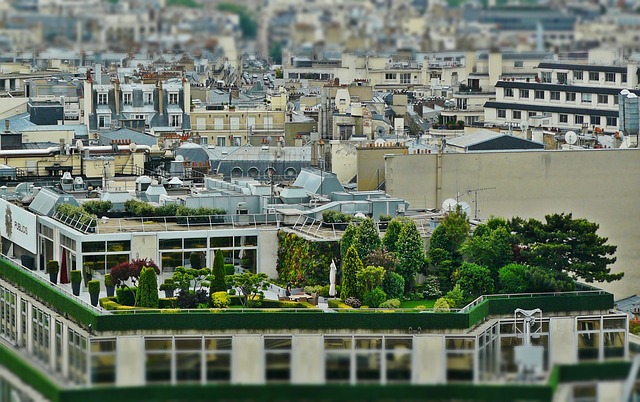Sustainable roof design is a powerful tool for environmental conservation, offering innovations like green roofing systems and solar-integrated roofs. These solutions reduce carbon footprints through improved insulation, rainwater absorption, and energy efficiency. Eco-friendly materials lower cooling costs, enhance air quality, and provide wildlife habitats. Solar-integrated designs generate clean energy while maintaining aesthetic appeal. As the construction industry embraces sustainability, these environmentally friendly roof installations gain popularity, contributing to a greener future with cost savings.
Reducing our carbon footprint is a collective effort, and the built environment plays a significant role. This article explores how sustainable building practices, with a specific focus on roofs, can mitigate climate change. We delve into the impact of rooftops as carbon emitters and solvers, guiding you through proven sustainable roof design principles for environmental conservation. Furthermore, we uncover eco-friendly solutions, their energy efficiency benefits, and biodiversity enhancement. Finally, we turn our attention to the future of environmentally friendly roof installations: solar-integrated designs.
Understanding the Impact of Building Roofs on Carbon Footprint
The roof of a building is often an overlooked yet significant contributor to its carbon footprint. Traditional roofing materials and designs can lead to substantial energy losses, especially in terms of heating and cooling. However, embracing sustainable roof design offers a powerful solution to mitigate this impact. Eco-friendly roof solutions, such as green roofing systems, incorporate vegetation that provides excellent insulation, reduces the urban heat island effect, and absorbs rainwater, thereby decreasing the need for energy-intensive stormwater management.
Sustainable roofing materials play a crucial role in minimizing the carbon footprint of buildings. Energy-efficient roof designs use reflective coatings to bounce sunlight away, reducing the need for air conditioning. Additionally, solar-integrated roof designs that incorporate photovoltaic panels not only provide clean energy but also serve as durable and eco-friendly roofing solutions. These innovations contribute to overall energy savings, lower greenhouse gas emissions, and a greener environment, making green roof installation an increasingly popular choice among environmentally conscious builders and property owners.
Sustainable Roof Design Principles for Environmental Conservation
Sustainable roof design plays a pivotal role in reducing carbon footprints and contributing to environmental conservation. Eco-friendly roof solutions like green roofing systems offer a plethora of benefits, including mitigating urban heat island effects, improving air quality, and providing habitats for local wildlife. By incorporating sustainable roofing materials, buildings can achieve energy efficiency, lowering cooling costs and decreasing their overall environmental impact.
The integration of solar panels into roof designs is another innovative approach, transforming rooftops into valuable space for renewable energy generation. Solar-integrated roof installations not only contribute to a greener environment but also offer long-term cost savings for building owners. These eco-conscious practices are gaining traction as the construction industry shifts towards more sustainable solutions, ensuring a brighter and greener future for all.
Exploring Eco-Friendly Roof Solutions: Materials and Technologies
Exploring Eco-Friendly Roof Solutions involves a deep dive into innovative materials and technologies that revolutionize sustainable roofing. Among the leading options are green roofing systems, which incorporate growing media and vegetation to insulate buildings, mitigate heat islands, and absorb rainwater. These eco-friendly roof solutions not only enhance aesthetic appeal but also significantly reduce energy consumption by providing natural insulation.
Advancements in sustainable roofing materials have expanded the range of green options. From recycled rubber and plastic to organic sheep’s wool and biodegradable fiber, these materials offer exceptional performance while minimizing environmental impact. Moreover, solar-integrated roof designs combine photovoltaic panels with traditional roofing systems, maximizing energy efficiency and turning rooftops into productive spaces that contribute to a building’s overall sustainability and lower carbon footprint.
Benefits of Green Roofing Systems in Energy Efficiency and Biodiversity
Green roofing systems offer a multitude of benefits for both buildings and their surroundings. In terms of energy efficiency, these sustainable roof designs can significantly reduce heating and cooling costs. The plants and soil layer act as natural insulation, helping to regulate indoor temperatures. During warmer months, the vegetation provides shade, lowering the need for air conditioning. Conversely, in colder seasons, the root systems help retain heat, decreasing the demand for heating.
Biodiversity is another key advantage. Green roofs provide habitats for a variety of plant and animal species, contributing to urban biodiversity. They serve as small oases in concrete jungles, attracting birds, insects, and small mammals, which in turn support local ecosystems. Moreover, these eco-friendly roof solutions filter pollutants from the air, improve water quality through runoff absorption, and enhance overall urban aesthetics, creating more livable and environmentally friendly spaces.
Integrating Solar Power: The Future of Environmentally Friendly Roof Installations
Integrating Solar Power represents a significant leap forward in sustainable roof design, offering both environmental and economic benefits. Eco-friendly roof solutions like solar-integrated designs are gaining popularity as green roofing systems that not only reduce a building’s carbon footprint but also provide long-term cost savings. By incorporating photovoltaic panels into roof structures, these innovative eco-friendly roof installations generate clean energy, contributing to overall energy efficiency.
Sustainable roofing materials play a crucial role in this transition, with options like recycled metal, solar shingles, and energy-efficient insulation minimizing the environmental impact of roof construction. Solar-integrated roof designs offer an aesthetically pleasing alternative to traditional roofs, allowing buildings to blend seamlessly into their surroundings while actively contributing to a greener future.
Sustainable building practices, with a focus on sustainable roof design and eco-friendly roof solutions, offer a compelling path to reducing our carbon footprint. By adopting green roofing systems that incorporate sustainable roofing materials and energy-efficient roof designs, we can mitigate climate change impacts while fostering biodiversity. Solar-integrated roof designs further enhance environmental benefits, positioning green roof installation as a future-forward strategy for environmentally friendly roof installations.
